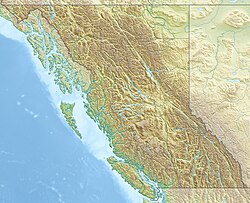Xnukw
| Xnukw Iknouk River | |
|---|---|
| Location | |
| Country | Canada |
| Province | British Columbia |
| District | Cassiar Land District |
| Physical characteristics | |
| Source | Boundary Ranges |
| • location | Coast Mountains |
| • coordinates | 55°9′36″N 129°33′13″W / 55.16000°N 129.55361°W[3] |
| • elevation | 1,147 m (3,763 ft)[2] |
| Mouth | Nass River |
• coordinates | 55°0′21″N 129°48′47″W / 55.00583°N 129.81306°W[1][2] |
• elevation | 0 m (0 ft)[4] |
| Length | 30 km (19 mi)[5] |
| Basin size | 111 km2 (43 sq mi),[6] |
| Discharge | |
| • average | 9.7 m3/s (340 cu ft/s)[6] |
| Basin features | |
| Topo map | NTS103P4 Greenville |
Xnukw (English pronunciation: nook[1]), formerly the Iknouk River, is a river in the northern coast part of the province of British Columbia, Canada.[1][7] From its source in the Boundary Ranges of the Coast Mountains Xnukw flows southwest for about 30 km (19 mi)[5] to empty into the lower Nass River near Nass Bay.
Xnukw's drainage basin covers 111 km2 (43 sq mi).[6] The river's mean annual discharge is estimated at 9.7 m3/s (340 cu ft/s).[6] Xnukw's watershed's land cover is classified as 37.2% conifer forest, 25.4% barren, 12.1% grassland, 10.1% shrub, 9.3% snow/glacier, and small amounts of other cover.[6] The mouth of Xnukw is located about 83 km (52 mi) north of Prince Rupert, about 77 km (48 mi) east of Ketchikan, Alaska, about 475 km (295 mi) west of Prince George, and about 785 km (488 mi) north of Vancouver.
The entire Xnukw's watershed is within the territory of the Nisga'a Nation as defined by the Nisga'a Treaty. The name "Xnukw" is from the Nisga'a language and means "place where spear (Chinook/spring salmon)", referencing a Nisga'a adaawak traditional story.[1]
Geography
[edit]The Xnukw river begins in the high peaks and glaciers of the Boundary Ranges of the Coast Mountains between the Nass River to the south and Observatory Inlet to the northwest. Its geologically new, glacier-made U-shaped valley runs in a nearly straight line to the southwest. The river Ksi Gingolx follows a similar southwest course, to the community of Ging̱olx, just west of Xnukw. Along its route Xnukw collects various small tributary streams flowing from highlands down into its valley. In its lower reach Xnukw flows between Sharp Peak on the east and Mount Woods on the west.[8][9] At its mouth Xnukw flows under the Nisga'a Highway (British Columbia Highway 113), after which a final tributary creek joins Xnukw before it empties into the Nass River estuary, just upriver from where the Nass River becomes Nass Bay and joins Portland Inlet.[10][11][2][12][13][14][15][16]
History
[edit]The Xnukw has been Nisga'a territory since time immemorial. The Nisga'a adaawak (oral history story) about Xnukw tells of a young man named Wiit'ax Daaw who once fished at a big rock located in the middle of the mouth of the river. He caught a large Chinook salmon by the tail but was unable to let go of his spear and was pulled out to sea. A law was then made: "Never should anyone club the spring salmon on the head after catching it, for fear it will put a curse on you." No one has held the name Wiit'ax Daaw ever since.[1]
The river was officially given the name "Iknouk River" by the government of British Columbia in 1953. Per the Nisga'a Treaty, its name was officially changed to "Xnukw" on 11 May 2000.[1]
Flora and fauna
[edit]The primary biogeoclimatic zone of the Xnukw watershed is "Coastal Western Hemlock" (CWH) zone, a conifer temperate rainforest dominated by western hemlock, western red cedar, and amabilis fir. At higher altitudes this zone merges into the "Mountain Hemlock" (MH) zone, characterized by the presence of mountain hemlock and the absence of red cedar.[17]
Xnukw is a major salmon-bearing river.[18]
See also
[edit]References
[edit]- ^ a b c d e f "Xnukw". BC Geographical Names.
- ^ a b c "Toporama (on-line map and search)". Atlas of Canada. Natural Resources Canada. Retrieved 2 May 2025.
- ^ Derived from BC Geographic Names, topographic maps, and Toporama
- ^ Elevation derived from ASTER Global Digital Elevation Model, using Toporama, BC Geographic Names coordinates, and topographic maps.
- ^ a b Length measured using BC Geographic Names coordinates, topographic maps, and Toporama
- ^ a b c d e "Northwest Water Tool". BC Water Tool. GeoBC, Integrated Land Management Bureau, Ministry of Agriculture and Lands, Government of British Columbia. Retrieved 27 April 2025.
- ^ "Xnukw". Geographical Names Data Base. Natural Resources Canada.
- ^ "Sharp Peak". BC Geographical Names.
- ^ "Mount woods". BC Geographical Names.
- ^ "Nass Bay". BC Geographical Names.
- ^ "Portland Inlet". BC Geographical Names.
- ^ British Columbia Road & Recreation Atlas. Benchmark Maps. 2024. p. 131. ISBN 978-1-926806-87-7.
- ^ Mussio, Russell; Mussio, Wesley (2018). Northern BC Backroad Mapbook. Mussio Ventures. pp. 32, 46. ISBN 979-8986387901. Retrieved 2 May 2025.
- ^ Map 103P013 (PDF) (Topographic map). 1:20,000. Government of British Columbia. 2016. Retrieved 2 May 2025.
- ^ Map 103P012 (PDF) (Topographic map). 1:20,000. Government of British Columbia. 2016. Retrieved 2 May 2025.
- ^ Map 103P002 (PDF) (Topographic map). 1:20,000. Government of British Columbia. 2016. Retrieved 2 May 2025.
- ^ "CDC iMap [web application]". British Columbia Conservation Data Centre. Retrieved 28 April 2025.
- ^ "State of Salmon - Nass". Pacific Salmon Foundation. Retrieved 2 May 2025.
External links
[edit]- "Nisg̱a'a Lisims Government". Nisg̱a’a Lisims Government.

